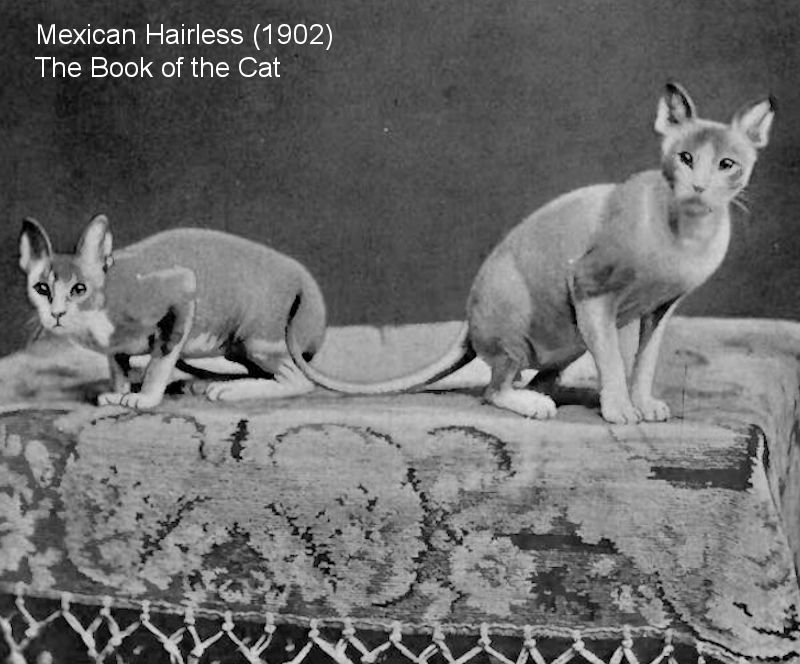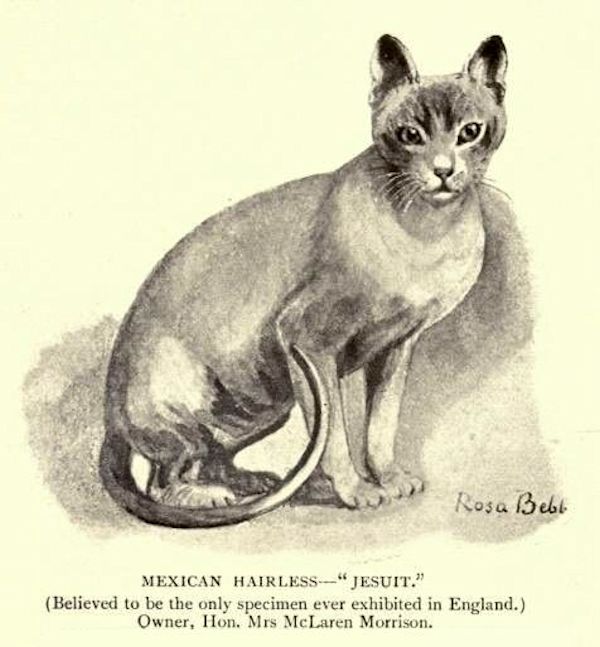SHORTHAIRED CATS OF THE 19TH CENTURY - MEXICAN SHORTHAIR AND MOMBASSA CAT
Miscellaneous Foreign Breeds (Frances Simpson)
In addition to the Siamese and Abyssinian, a number of other "Foreign" breeds were described or depicted in "The Book of the Cat". The "Burmese" cat, which appeared in a photograph, appears to be an Oriental ticked tabby, rather than the breed known today as the Burmese.
The section on Foreign cats was contributed by Mr H C Brooke. Among the Foreign breeds he described were the Chinese lop-eared cat, the South American dwarf cat and an early Rex or wirehair cat called the Mombassa cat.
"There is said to be a variety of Chinese cat which is remarkable for its pendent ears. We have never been able to ascertain anything definite with regard to this variety. Some years back a class was provided for them at a certain Continental cat show, and we went across in the hope of seeing, and if possible acquiring, some specimens; but alas the class was empty! We have seen a stuffed specimen in a Continental museum, which was a half long-haired cat, the ears being pendent down the sides of the head instead of erect; but do not attach much value to this."
"We have seen specimens of a very tiny domestic cat, full-grown individuals of which weigh only about three pounds. Those we saw came from South America."
"A cat called the Mombassa cat, from the East of Africa, is said to have a short coat of wiry texture."
"There are, of course, no cats indigenous to Australia. An American writer gives it as his opinion that a certain strain of Australian cats is derived from imported Siamese cats. A specimen we possessed last year, which was born on a ship during the passage from Australia, and which exactly resembled its dam, certainly had every appearance of being of Eastern origin. It had the marten-shaped head, and a triple kink in the tail; its voice also resembled that of the Siamese. In colour it was grey with dark spots."

The Mexican Hairless is also described, in the form of a letter written by E J Shinick to Mr H C Brooke regarding a pair of hairless cats which had come into Mr Shinick's possession. Being brother and sister, Shinick had not allowed the pair to breed. The male was killed by dogs and the writer was, at the time of the letter, seeking another specimen to mate with the surviving female and also hoping to sell the female to Mr Brooke.
"In answer would say my hairless cats are brother and sister. I got them from the Indians a few miles from this place. The old Jesuit Fathers tell me they are the last of the Aztec breed known only in New Mexico. I have found them the most intelligent and affectionate family pets I have ever met in the cat line; they are the quickest in action and smartest cats I have ever seen. They are fond of a warm bath, and love to sleep under the clothes at night with our little girl. They seem to understand nearly everything that is said to them; but I have never had time to train them. They are marked exactly alike - with mouse coloured backs; with neck, stomach and legs a delicate flesh tint. Their bodies are always warm and soft as a child's. They love to be fondled and caressed, and are very playful; will run up and down your body and around your waist like a flash.
"Nellie" weighs about eight pounds, and "Dick" weighed ten pounds; but I am sorry to say we have lost "Dick". We have never allowed them to go out of the house, as the dogs would be after them. They were very fond of our water spaniel, and would sleep with her. "Dick" was a sly rascal, and would steal out. One night last year he stole out, and the dogs finished him. His loss was very great, as I may never replace him. The Chicago Cat Club valued them at 1,000 dollars each. They were very anxious for me to come on with them for their cat shows, but I could not go. They were never on exhibition; as this is a small city, I feared they would be stolen. I have made every endeavour to get another mate for "Nellie", but have not been successful. I never allowed them to mate, as they were brother and sister, and I thought it might alter "Nellie's" beautiful form, which is round and handsome, with body rather long. In winter they have a light fur on back and ridge of tail, which falls off in warm weather. They stand the cold weather the same as other cats. They are not like the hairless dogs, whose hide is solid and tough; they are soft and delicate, with very loose skin.
"Nellie" has a very small head, large amber eyes, extra long moustache and eyebrows; her voice now is a good baritone, when young it sounded exactly like a child's. They have great appetites, and are quite dainty eaters - fried chicken and good steak is their choice. Have never been sick an hour. The enclosed faded picture is the only one I have at present - it is very lifelike, as it shows the wrinkles in its fine, soft skin. "Dick" was a very powerful cat; could whip any dog alone; his courage, no doubt, was the cause of his death. He always was the boss over our dogs. I have priced "Nellie" at 300 dollars. She is too valuable for me to keep in a small town. Many wealthy ladies would value her at her weight in gold if they knew what a very rare pet she is. I think in your position she would be a very good investment to exhibit at cat shows and other select events, as she doubtless is the only hairless cat now known. I have written to Old Mexico and all over this country without finding another. I would like to have her in some large museum where she would interest and be appreciated by thousands of people." E J Shinick, Albuquerque, New Mexico, February 3rd, 1902
In “Animal Life and the World of Nature” (Vol 1, 1902-1903), Shinick was quoted "Dick was a very powerful cat, and could whip any dog alone; his courage no doubt was the cause of his death. He was a sly rascal and would steal out, and one night he got out and several dogs killed him. His loss was very great and I may never replace him. The Chicago Cat Club valued him at 1,000 dollars. I have sent all over the country and endeavoured to get a mate for 'Nellie,' but I fear the breed is extinct."

This illustration, from Charles Henry Lane's book "Rabbits, Cats and Cavies" (1903) is a portrait of a Mexican Hairless Cat called "Jesuit" that belonged to the Hon. Mrs McLaren Morrison. It was the only specimen the author had been shown and he believed it to be the only one ever exhibited in England. This would have been Nellie, bought as a pet and exhibited under a different name reflecting Shinick's reference to the old Jesuit Fathers.